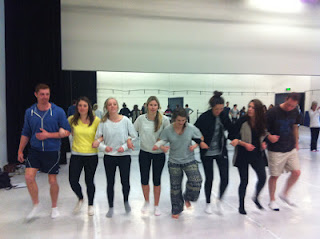Lecturer: Jacqui Dreessens
August 30, 2012
Indigenous dance (Aboriginal & African) – ceremonial
dance, use of animal movements, one with the earth
Aboriginal dancing – way they and how they stamp their feet,
body paintings to show the region they come from
o
Traditional dance past from generation to
generation
o
Usually only minor modifications are made dur to
the cultural significance found in these dance.
o
Ceremonial dance,
o
Use of animal movements,
o
One with the earth
o
Use of stomping onto the Earth’s surface with a
flat foot
-
Take pieces of traditional dances and creating a
new dance using those movements
-
Need permission from Elders to put dances onto
public domain (Youtube)
-
The Dreaming – continuous, not just a time past
Kingfisher – responsible for taking the
spirit/energy of the dead to the resting place. Spirits rest there until
reincarnation
-
Can be a way of teaching a part of peace.
-
Connecting to another domain in
o
VELS
-
Good way of teaching core movements, balance,
warm-up, coordination
African Dance
Similar to Aboriginal Dance as it is used for ceremonial
dance but also incorporates social dance into its tribes. They use animal like
movements to portray an aspect of the land and what it represents to the
people.
The dances are often performed as showing of what life
involves.
Activities
Use simple costuming such as bandanas, scrap material to
enhance connection to the movement.
- Kookaburra dance;
o
Moving around the space as a kookaburra would,
perching on branches, creating nests and searching for food.
o
Snake Dance
o
Whole group moving as one to imitate the
movement of a snake.
o
Direction, levels and body movements performed
in cannon as it moves down the snake’s body.
African Warrior Dance.
o
Represents elephants working as a team to
protect the herd
o
Linked arms to make a long chain, with a leader
in the centre
o
A dance of war and honour,
o
aggressive body movements are used through
marching in unison with knees bent slightly while proclaiming a warrior chant
Methods – working in an inclusive way, regardless of
cultural, religious and traditional backgrounds
Direct teaching method – copying movements exactly
-
Stylistic, usually seen in ballet, hip hop,
jazz, tap, calisthenics
-
Comes from a moment in time, eg. Michael Jackson
– James Brown – Swing
-
Comes from a given culture at that point in time
-
Need to be very careful about what style you
choose.
I In The School Setting
The traditional dances learned during this workshop would be suitable for students in the senior section of a primary school to allow discussion on the origins of the dance and the deep cultural significance that is embedded within the dance. These dances would be great to incorporate with Humanities units that enable a look into traditional cultural dance.
References:
Aboriginal Dances from Lockhart River (2), 2010, YouTube, 23 February, retrieved 4 September 2012, <http://www.youtube.com/watch?v=FDj9Thm3m5o>
I In The School Setting
The traditional dances learned during this workshop would be suitable for students in the senior section of a primary school to allow discussion on the origins of the dance and the deep cultural significance that is embedded within the dance. These dances would be great to incorporate with Humanities units that enable a look into traditional cultural dance.
References:
Traditional South African Dance, 2010, YouTube, 3 October, retrieved 4 September 2012, <http://www.youtube.com/watch?v=a5NcZSHuPmU>




No comments:
Post a Comment